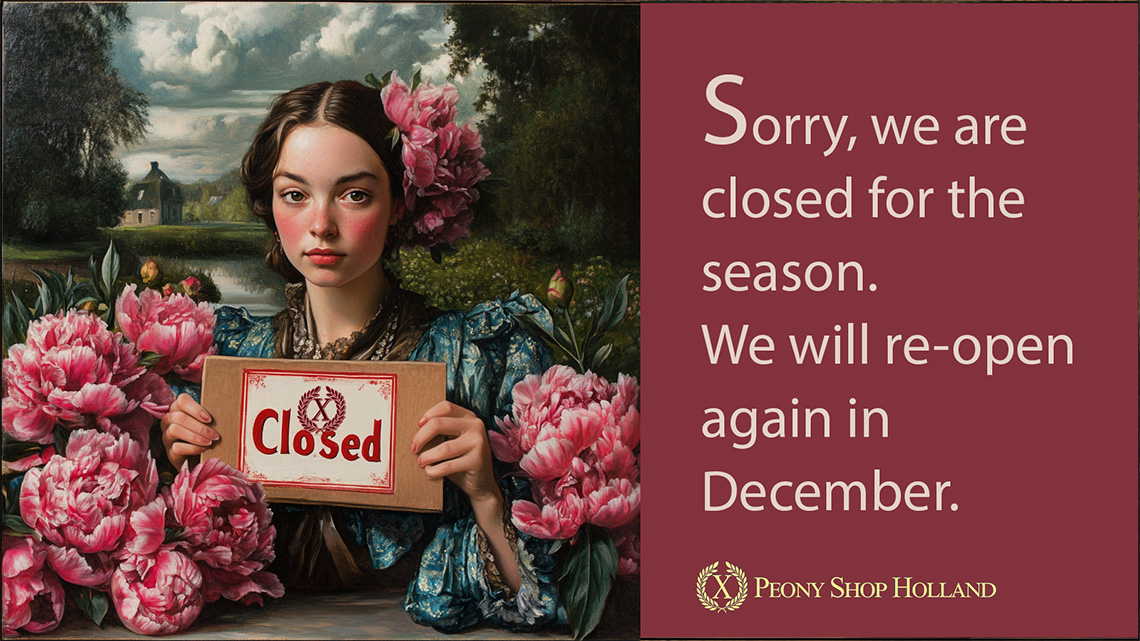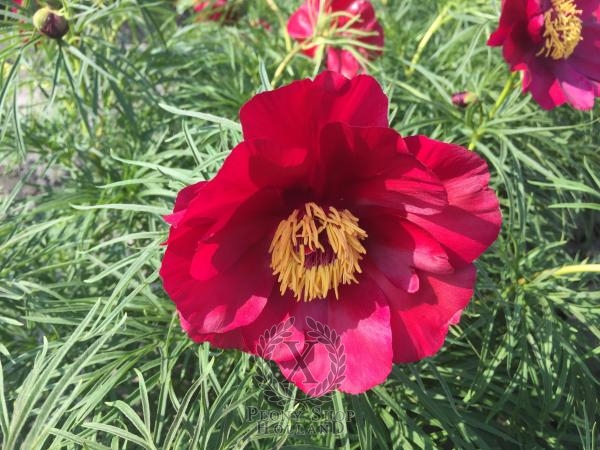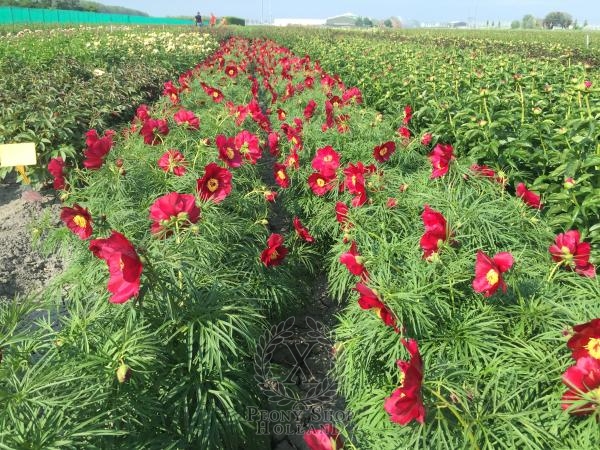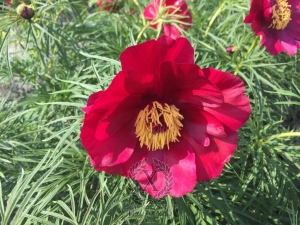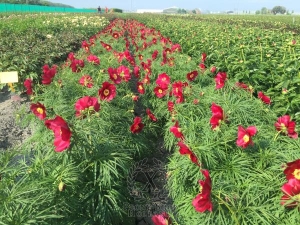Peony Earlybird
Peony Earlybird is one of the many red dwarf Peonies that we grow at Peony Nursery Peony Shop Holland
Rock Garden Peonies
Peony Earlybird belongs to the Rock Garden Peonies These rock garden peonies are the shortest varieties we grow! Very charming, herbaceous perennials, our rock garden peonies have foliage, texture and blossoms sized in perfect proportion to their smaller stature. Rock-garden varieties are named for their short heights (generally below 21") and their adaptability for today's smaller landscapes and gardens.Professor A. P. Saunders Hybrids
Peony Earlybird has been breed by A chemistry Professor at Hamilton College, Clinton, New York during the early part of the 20th century, Professor Saunders is today considered the "Father" of the modern hybrid peony. He carried out extensive, scientifically based breeding programs with both herbaceous and Tree Peonies with the assistance of friends at the New York Botanical Garden. His Tree Peony work centered on the intercrossing of two species, the yellow flowered P. lutea and the orange-red P. delavayi with existing classical Japanese Moutan varieties. The resultant progeny produced a range of flower colors from lemon and golden yellow to ivory and pearl shades frequently blended and suffused with purple and pink, plus a few strawberry-red cultivars. In all cases, the flowers are displayed above attractive cut-leaf foliage. Eventually his daughter, Silvia took over her father's nursery, and after several decades Professor Saunder's hybrids are still in great demand by gardeners worldwide.Peony Soil
Peonies love good drained rich organic nutritious soils. Over the years we have developed a tedious process for growing the highest quality of peonies possible. As our company is located in the northern part of the Netherlands, we are blessed and cursed with a heavy clay soil. On the one hand side this soil is perfect for peony growth and therefore nature helps us to grow the biggest, highest quality peonies fast. On the other hand the clay ground forces us to take extensive measures before storing or exporting the peony roots. For cut-flower production it doesn't matter, once planted they enjoy the rich nutritious clay soil and become to compare with sand soils,, not only stronger as plant in general, but also much faster into production and shown bigger size Peony heads!
Peony planting of Earlybird
Peonies can be planted manually or mechanically. We have chosen to plant our Exclusive Peonies manually and the other Peonies by machine.
Before planting the peonies, the soil needs to be prepared well. This is a crucial element in the peony growing process. First the soil where the roots is grown needs to be properly flattened and drained in order to prevent potential water damage (from heavy rain).
After having cultivated the land properly (with a milling- or spade-machine) the roots are to be planted at a depth of 2 - 3 cm. This depth is very decisive because if the roots are planted too deep, the production of flowers will diminish or even completely vanish. The distance between the cuttings depends on the variety. Some varieties need more or less space than others. Furthermore, the time-period that roots will remain on a particular spot has to be taken into consideration as well.
Fertilizing and Weeding the Peonies
Peonies must be fertilized during the winter months. There is no rule to the amount of usage of each element (Nitrogen, Phosphorus, Potassium), because this depends on the nature of the soil. Peonies flourish best on soil with a pH from 6 to 7.
During the winter season chemicals against weeds can be used as well. It is important to do this during the cold season, because then the roots are at "rest" (dormant). Otherwise the roots are apt to absorb the chemicals which will cause damage to the peony.
When the young root starts growing in spring several kind of preventive fungicides can be used. This can be persisted until two weeks before harvesting.

Theo is about to 'feed' the peonies
Upcoming of the Peonies in Early Spring
When the first Peonies show up in February / March, the use of wind fences can be most helpful to protect the still vulnerable peony plants. The fences are usually placed from the east to west to keep the cold northern wind out.
No gates are placed from south to north because that allows the wind to keep the plants dry and prevent the spread of Botrytis. When the plants are still small and vulnerable to diseases, copper sulphate can be used to ensure a firm and healthy plant. Several fungicides can be used to protect the plants against Botrytis (preventive).
Mowing the Peonies
The mowing of peonies takes place at the end of August. It is very important that all dead organic material is removed because all kind of diseases lives in dead organic material.
This material can be gathered by a tractor with a sweeping tool attached or by hand with picking forks. The last remains must always be removed manually.
Regarding Peony Nursery "Peonyshop.com" Peony Shop Holland Lutjebroek
Peony Nursery Peonyshop.com Peony Shop Holland nowadays primarily centers at expanding unique, exceptional good quality peonies. It hasn't always been this situation. The company has got a successful history starting up in the year 1875 accompanied by Simon Scholten that had been growing veggies for income.
In 2001 the firm formed their very own new marketing and advertising-label & brand "Peonyshop.com" and they began focusing on growing unique peonies. Within the year 2002 the particular firm opened up their very own shop on the web", the: peonyshop.com together with Peonies & Buxus. Throughout 2003 Joshua Scholten started off on with breeding peonies. After that in 2004 this particular company started to foreign trade peonies of the Netherlands throughout Europe, Usa and Asia.
Currently our peony nursery is specialized in improving and increasing the number of special, high quality peony roots which have been distributed and exported to anywhere in the world. Furthermore the particular organization additionally cut peonies primarily supporting the Dutch peony flower industry.
The main things we pride:- The superior quality of our product
- The capacity to foreign trade around the world
- Our new substantial collection of single dwarf red peonies like Earlybird
- Our Nursery stock of substantial full potential single dwarf red peonies for the garden or for potting.
About Earlybird a dwarf red peony
The fall season is really the correct time if you consider growing peony plants. Nearly all peonies are generally unbelievably long-term-lived plants staying around close to 50 to a maximum of 70 years, so once you'll have them planted correctly, an individual will definitely benefit from them for years. Peonies like a sunny location together with a well-drained ground. A good quality air flow circulation available around the plant is also crucial. All these milieu support this type of plants to stay away from sickness issues. To arrange the sowing hole for the purpose of a bare-root peony, dig the soil to a depth of 12-18". Make use of a garden fork to release the sides of the particular growing hole at the same time. It really is really crucial that the particular "eye", or growth nodes, located near the bottom of the old stem, end up no greater than Two " below the ground surface.
